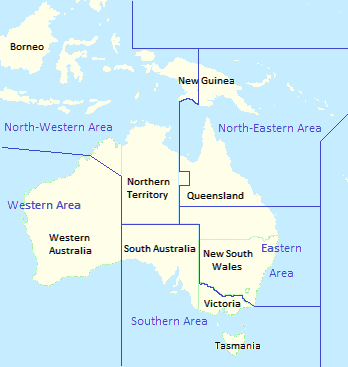Central Area Command (RAAF) on:
[Wikipedia]
[Google]
[Amazon]
Central Area Command was one of several geographically based commands raised by the
''Royal Australian Air Force'', pp. 91–92
/ref> The roles of these area commands were air defence, protection of adjacent sea lanes, and aerial reconnaissance. Each was led by an Air Officer Commanding (AOC) responsible for the administration and operations of all air bases and units within his boundary. No. 2 Group, which had been established on 20 November 1939, was re-formed as one of the first two area commands, Central Area, on 7 March 1940. Headquartered in
 The RAAF's area command structure was revised in 1942, following the outbreak of the
The RAAF's area command structure was revised in 1942, following the outbreak of the
Royal Australian Air Force
"Through Adversity to the Stars"
, colours =
, colours_label =
, march =
, mascot =
, anniversaries = RAAF Anniversary Commemoration ...
(RAAF) during World War II. It was formed in March 1940, and covered the central portion of New South Wales. Headquartered at Sydney
Sydney ( ) is the capital city of the state of New South Wales, and the most populous city in both Australia and Oceania. Located on Australia's east coast, the metropolis surrounds Sydney Harbour and extends about towards the Blue Mountain ...
, Central Area Command was responsible for air defence, aerial reconnaissance and protection of the sea lanes within its boundaries. It was disbanded in August 1941 and control of its units taken over by other RAAF formations. Proposals in 1943–44 to raise a new Central Area Command did not come to fruition.
History
Prior to World War II, theRoyal Australian Air Force
"Through Adversity to the Stars"
, colours =
, colours_label =
, march =
, mascot =
, anniversaries = RAAF Anniversary Commemoration ...
was small enough for all its elements to be directly controlled by RAAF Headquarters in Melbourne. After war broke out in September 1939, the RAAF began to implement a decentralised form of command, commensurate with expected increases in manpower and units.Stephens, ''The Royal Australian Air Force'', pp. 111–112 Its initial move in this direction was to create Nos. 1 and 2 Groups to control units in Victoria and New South Wales, respectively. Then, between March 1940 and May 1941, the RAAF divided Australia and New Guinea into four geographically based command-and-control zones: Central Area, Southern Area, Western Area, and Northern Area.Gillison''Royal Australian Air Force'', pp. 91–92
/ref> The roles of these area commands were air defence, protection of adjacent sea lanes, and aerial reconnaissance. Each was led by an Air Officer Commanding (AOC) responsible for the administration and operations of all air bases and units within his boundary. No. 2 Group, which had been established on 20 November 1939, was re-formed as one of the first two area commands, Central Area, on 7 March 1940. Headquartered in
Sydney
Sydney ( ) is the capital city of the state of New South Wales, and the most populous city in both Australia and Oceania. Located on Australia's east coast, the metropolis surrounds Sydney Harbour and extends about towards the Blue Mountain ...
, Central Area Command was given control of all Air Force units in New South Wales except those in the southern Riverina and the north of the state. Units in Queensland were also temporarily assigned to its control, pending the formation of Northern Area. Central Area's inaugural AOC was Air Commodore Adrian "King" Cole, who had also led No. 2 Group.Ashworth, ''How Not to Run an Air Force'', pp. 302–304 His senior air staff officer was Wing Commander Alan Charlesworth.
In May 1940 the area's headquarters moved from "Mt Loana" in Point Piper to the mansion "Kilmory" close by. Cole handed over command of Central Area to Air Commodore Bill Anderson in December 1940. By August 1941, the RAAF's expanding instructional program necessitated the establishment of overarching training organisations on a semi-functional, semi-geographical basis. Accordingly, No. 2 (Training) Group was formed in Sydney, taking responsibility for the training units then under Central Area, which was disbanded. Control of other Central Area units was "divided as convenient", according to the official history of the war, between Northern and Southern Area Commands.
Aftermath
 The RAAF's area command structure was revised in 1942, following the outbreak of the
The RAAF's area command structure was revised in 1942, following the outbreak of the Pacific War
The Pacific War, sometimes called the Asia–Pacific War, was the theater of World War II that was fought in Asia, the Pacific Ocean, the Indian Ocean, and Oceania. It was geographically the largest theater of the war, including the vast ...
: Northern Area was split into North-Eastern Area and North-Western Area, and a new command covering New South Wales and southern Queensland, Eastern Area, was created, making a total of five commands. In October 1943, the Air Board proposed carving a new Central Area Command out of Eastern Area, which by then was considered too large to be controlled by one headquarters and therefore ripe for subdivision. This Central Area Command would have been responsible for training and operational units in southern Queensland. The War Cabinet deferred its decision on the proposal. The concept was raised again in August 1944, and this time the new Central Area Command was to control maintenance units, as well as training and operations, in southern Queensland. Once again, nothing came of the proposal.Ashworth, ''How Not to Run an Air Force'', pp. 227–228
Notes
References
* * * {{RAAF area commandsCentral
Central is an adjective usually referring to being in the center of some place or (mathematical) object.
Central may also refer to:
Directions and generalised locations
* Central Africa, a region in the centre of Africa continent, also known as ...
Military units and formations established in 1940
Military units and formations disestablished in 1941
RAAF commands